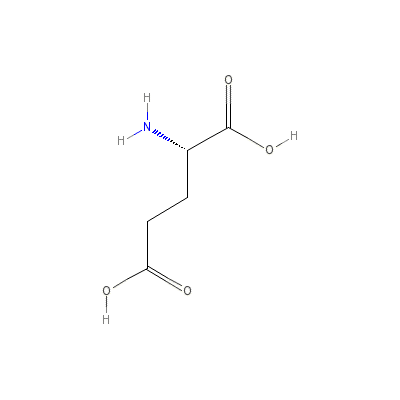2-Aminoglutaric acid




Categoria
2-Aminoglutaric acid Nombres de marca, 2-Aminoglutaric acid Analogos
- (2S)-2-Aminopentanedioic acid
- (S)-(+)-Glutamic acid
- (S)-2-Aminopentanedioic acid
- (S)-Glutamic acid
- 1-Aminopropane-1,3-dicarboxylic acid
- 2-Aminoglutaric acid
- 2-Aminopentanedioic acid
- Aciglut
- E 620
- Glusate
- Glutacid
- Glutamic acid
- Glutamic acid, L-
- Glutamicol
- Glutamidex
- Glutaminic acid
- Glutaminol
- Glutaton
- L-(+)-Glutamic acid
- L-Glutamate
- L-Glutamic acid
- L-Glutamic acid (JAN)
- L-Glutaminic acid
- L-a-Aminoglutaric acid
- Pentanedioic acid, 2-amino-, (S)-
- a-Aminoglutaric acid
- a-Glutamic acid
2-Aminoglutaric acid Marca los nombres de mezcla
2-Aminoglutaric acid Formula quimica
C5H9N1O4
2-Aminoglutaric acid RX enlace
No information avaliable
2-Aminoglutaric acid FDA hoja
2-Aminoglutaric acid MSDS (hoja de seguridad de materiales)
2-Aminoglutaric acid Sintesis de referencia
No hay información disponible
2-Aminoglutaric acid Peso molecular
147.130 g/mol
2-Aminoglutaric acid Punto de fusion
205 oC
2-Aminoglutaric acid H2O Solubilidad
No hay información disponible
2-Aminoglutaric acid Estado
Solid, white crystalline powder
2-Aminoglutaric acid LogP
-1.43 +/- 0.31
2-Aminoglutaric acid Formas de dosificacion
No hay información disponible
2-Aminoglutaric acid Indicacion
Además de ser uno de los bloques de construcción en la síntesis de proteínas, que es el neurotransmisor más extendido en la función cerebral, como un neurotransmisor excitatorio y como precursor para la síntesis de GABA en las neuronas GABAérgicas.
2-Aminoglutaric acid Farmacologia
Considera que la naturaleza de "alimento del cerebro", mediante la mejora de las capacidades mentales, ayuda a acelerar la curación de las úlceras; da una "elevación" de la fatiga, ayuda a controlar el alcoholismo, la esquizofrenia y el ansia de azúcar.
2-Aminoglutaric acid Absorcion
Absorbe la luz del intestino delgado en el enterocytes.Absorption es eficiente y se produce por un mecanismo de transporte activo.
2-Aminoglutaric acid Toxicidad
El glutamato provoca daño neuronal y muerte celular eventual, sobre todo cuando los receptores NMDA se activan, las dosis altas de ácido glutámico puede incluir síntomas tales como dolores de cabeza y problemas neurológicos.
2-Aminoglutaric acid Informacion de Pacientes
It is an important excitatory neurotransmitter, and glutamic acid is also important in the metabolism of sugars and fats. It helps with the transportation of potassium across the blood-brain barrier, although itself does not pass this barrier that easily. It also shows promise in the future treatment of neurological conditions, ulcers, hypoglycemic come, muscular dystrophy, epilepsy, Parkinson's, and mental retardation. Glutamic acid can be used as fuel in the brain, and can attach itself to nitrogen atoms in the process of forming glutamine, and this action also detoxifies the body of ammonia. This action is the only way in which the brain can be detoxified from ammonia. The fluid produced by the prostate gland also contains amounts of glutamic acid, and may play a role in the normal function of the prostate.
2-Aminoglutaric acid Organismos afectados
Humanos y otros mamíferos














